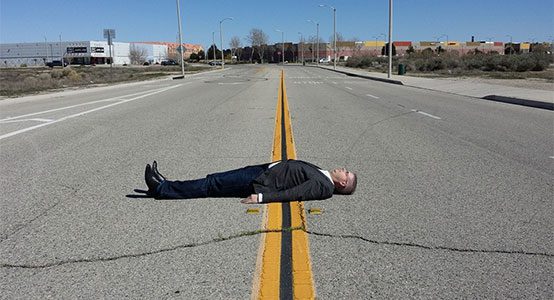The following comes from The Archimedes Codex, a book about the discovery of an ancient manuscript from Archimedes--the guy whose "Eureka!" moment heralded the discovery of specific gravity.
The book itself reads like the real-life adventures of Indiana Jones, but it also recounts Archimedes' proof of how one calculates the area of a parabolic segment (the yellow that includes triangle ABC below) as a proportion of the triangle it encloses. The added lines are part of the proof.

Among other his other enterprises, Archimedes was the architect of the defenses of Syracuse, a rival to Rome who sided with Carthage. When the Romans finished off the Carthaginians, they came after Syracuse, a Greek colony off the "toe" of Italy's "boot." At first Archimedes' defenses were too much for them, but eventually, some Syracusan defenders got drunk, the Romans got in, and that was the end of Archimedes. A cautionary tale.
What’s remarkable about this proof is that Archimedes uses infinity -- something both outside the province of Greek mathematics, prefiguring calculus. Since Archimedes lived around 270 BC, it was quite the leap.
One more astonishing thing about this proof is that he uses no numbers. In fact, he had nothing like Arabic (actually Indian) numerals.
A few comments about the drawing:
The line CZ is a tangent to the parabola (sorry, primitive drawing tools make it appear otherwise).
K is the mid-point of AZ
B is the mid-point of DE
Triangle AKC is half the area of AZC
B is the mid-point of KC
Triangle ABC is half AKC
The above, together, means that triangle AZC is four times the area of ABC.
Since this is a parabola, any line drawn parallel to the axis of the parabola (BD), say MX repeats the proportion of the perpendicular. So MX is to OX as AC is to AX, or MX:OX::AC:AX.
More comments:
Extending line CB cuts MX at point N, and cuts ZA at point K. The segment KT is the same as KC. In other words, K is the mid-point of CT.
Archimedes then duplicated the random line segment OX in SH, suspending it at the mid point, T.
So, as MX is to OX, so AC to AX
Also as AC is to AX, so KC to KN
Combined: MX is to OX as KC to KN, and since K is a midpoint, MX is to OX as TK is to KN.
And since they are identical, whatever is true for OX is true for SH: MX is to SH as TK is to KN.
Imagine, then that MX and SH are on a balance, with its fulcrum at K. Both lines weigh something in proportion to their lengths, and are on that balance at their centers of gravity (the idea center of gravity was Archimedes’ discovery -- a prerequisite for all subsequent physics.... How else would we be able to calculate planetary orbits?). The idea of treating lines as physically weighty was another of Archimedes’ innovations.
Remember: MX:SH::TK:KN, so the ratio of weight between MX and SH is the ratio of their lengths. The ratio of lines to balance such weights on a fulcrum is the inverse ratio to their weights, so MX and SH will always balance with K as their fulcrum on line TN.
So the random line, MX, always balances its smaller section OX around the fulcrum K when that smaller segment is transposed so its center becomes point T. The ratios will change, but they will remain proportional.
In other words, each parallel inside the triangle AZC balances its respective section from the parabolic segment ABC (positioned at T) around fulcrum K.
Therefore, all parallel lines (an infinite number) inside AZC balance all sections of the parabolic segment at K.
In other words, the triangle AZC, as a whole, balances the parabolic segment ABC, as a whole, at fulcrum K, when suspended at its center of gravity, T.
Where is the center of gravity for triangle AZC? It’s one-third of the median line KC. Since 1/3 of KC is also one third of KT, the parabolic segment is three times as far from the fulcrum as is the triangle. Therefore, the triangle must be three times the weight of the parabolic segment, and the area of the triangle (AZC) must be three times the area of the parabolic segment.
Since ABC is 1/4 the size of AZC, the parabolic segment ABC is 4/3 the triangle ABC.
In other words: the area of the parabolic segment is four-thirds the area of the triangle it encloses.
The book itself reads like the real-life adventures of Indiana Jones, but it also recounts Archimedes' proof of how one calculates the area of a parabolic segment (the yellow that includes triangle ABC below) as a proportion of the triangle it encloses. The added lines are part of the proof.
Among other his other enterprises, Archimedes was the architect of the defenses of Syracuse, a rival to Rome who sided with Carthage. When the Romans finished off the Carthaginians, they came after Syracuse, a Greek colony off the "toe" of Italy's "boot." At first Archimedes' defenses were too much for them, but eventually, some Syracusan defenders got drunk, the Romans got in, and that was the end of Archimedes. A cautionary tale.
What’s remarkable about this proof is that Archimedes uses infinity -- something both outside the province of Greek mathematics, prefiguring calculus. Since Archimedes lived around 270 BC, it was quite the leap.
One more astonishing thing about this proof is that he uses no numbers. In fact, he had nothing like Arabic (actually Indian) numerals.
A few comments about the drawing:
The line CZ is a tangent to the parabola (sorry, primitive drawing tools make it appear otherwise).
K is the mid-point of AZ
B is the mid-point of DE
Triangle AKC is half the area of AZC
B is the mid-point of KC
Triangle ABC is half AKC
The above, together, means that triangle AZC is four times the area of ABC.
Since this is a parabola, any line drawn parallel to the axis of the parabola (BD), say MX repeats the proportion of the perpendicular. So MX is to OX as AC is to AX, or MX:OX::AC:AX.
More comments:
Extending line CB cuts MX at point N, and cuts ZA at point K. The segment KT is the same as KC. In other words, K is the mid-point of CT.
Archimedes then duplicated the random line segment OX in SH, suspending it at the mid point, T.
So, as MX is to OX, so AC to AX
Also as AC is to AX, so KC to KN
Combined: MX is to OX as KC to KN, and since K is a midpoint, MX is to OX as TK is to KN.
And since they are identical, whatever is true for OX is true for SH: MX is to SH as TK is to KN.
Imagine, then that MX and SH are on a balance, with its fulcrum at K. Both lines weigh something in proportion to their lengths, and are on that balance at their centers of gravity (the idea center of gravity was Archimedes’ discovery -- a prerequisite for all subsequent physics.... How else would we be able to calculate planetary orbits?). The idea of treating lines as physically weighty was another of Archimedes’ innovations.
Remember: MX:SH::TK:KN, so the ratio of weight between MX and SH is the ratio of their lengths. The ratio of lines to balance such weights on a fulcrum is the inverse ratio to their weights, so MX and SH will always balance with K as their fulcrum on line TN.
So the random line, MX, always balances its smaller section OX around the fulcrum K when that smaller segment is transposed so its center becomes point T. The ratios will change, but they will remain proportional.
In other words, each parallel inside the triangle AZC balances its respective section from the parabolic segment ABC (positioned at T) around fulcrum K.
Therefore, all parallel lines (an infinite number) inside AZC balance all sections of the parabolic segment at K.
In other words, the triangle AZC, as a whole, balances the parabolic segment ABC, as a whole, at fulcrum K, when suspended at its center of gravity, T.
Where is the center of gravity for triangle AZC? It’s one-third of the median line KC. Since 1/3 of KC is also one third of KT, the parabolic segment is three times as far from the fulcrum as is the triangle. Therefore, the triangle must be three times the weight of the parabolic segment, and the area of the triangle (AZC) must be three times the area of the parabolic segment.
Since ABC is 1/4 the size of AZC, the parabolic segment ABC is 4/3 the triangle ABC.
In other words: the area of the parabolic segment is four-thirds the area of the triangle it encloses.







